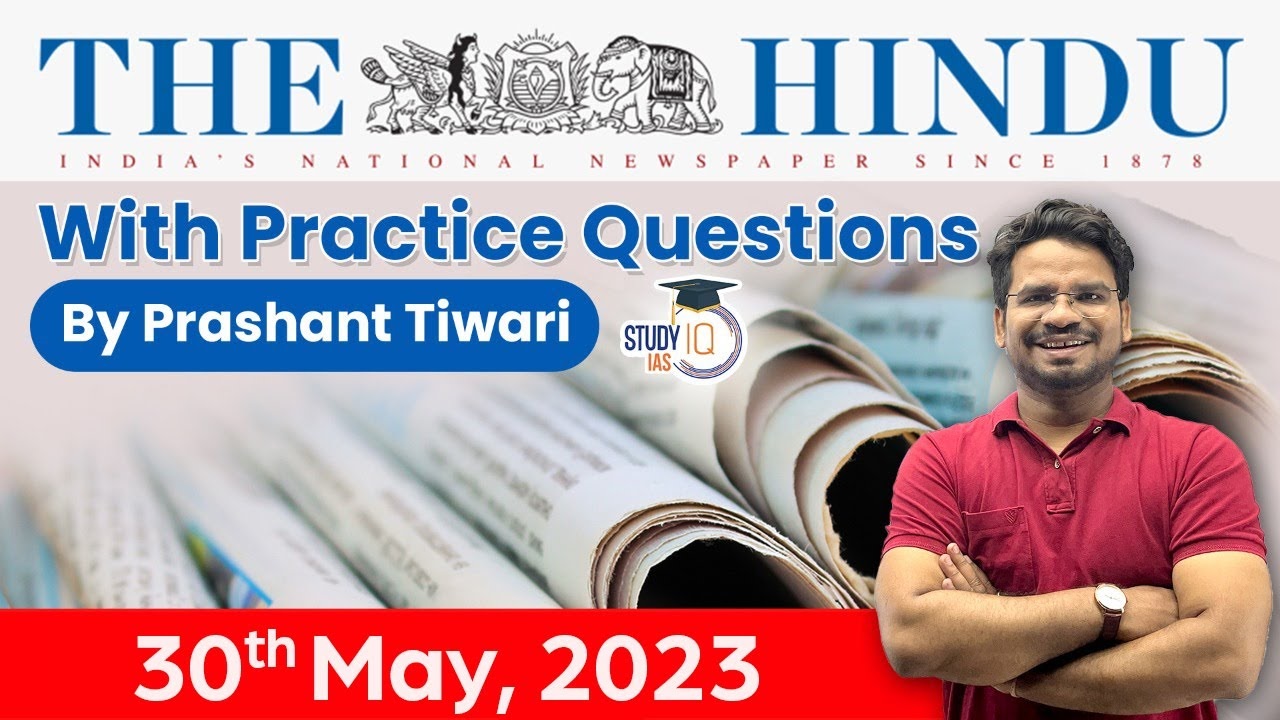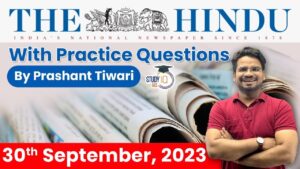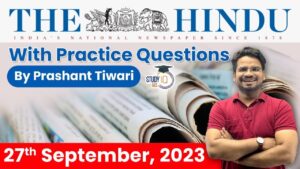The Hindu Newspaper Analysis for UPSC

The Hindu Newspaper Analysis 29 May 2023
- The Scheduled Tribe Demand Committee of Manipur (STDCM) began demanding ST status for the Meiteis in 2012.
- The Meiteis were recognised as a tribe before the merger of the State with the Union of India in 1949. The ST status is needed to “preserve” the community and “save the ancestral land, tradition, culture, and language” of the Meiteis.
- In 1972, the union territory of Manipur became 19th state of India.
- Their population was 59% of the total population of Manipur in 1951 and has now been reduced to 44% as per 2011 Census data.
- Kuki Tribe
- Kuki tribe is majorly found in Manipur with other states of North Eastern India.
- ‘Mim Kut’ is the main festival of the Kuki tribe.
The Hindu Editorial Today

- Later this year, India will have a new ‘supercomputer’ or, more correctly, an upgraded ‘high performance computing (HPC)’ system that will arguably be its fastest. This system is to be made and installed by the French corporation, Atos — an information technology service and consulting company.
- India’s most powerful such machines, Mihir and Pratyush.
- Floating point operations per second (FLOPS) are an indicator of computer processing abilities and 1 petaflop is a 1,000 trillion flops.
- The to-be installed French machines are expected to be 18 petaflops and India already has a handful of machines at multiple research institutions in the petaflop range.

- This is a right to bail that accrues when the police fail to complete investigation within a specified period in respect of a person in judicial custody.
- It is also known as Statutory Bail.
- This is enshrined in Section 167(2) of the Code of Criminal Procedure (CrPC).
- Section 167(2) of the CrPC:
- If the police are unable to complete an investigation within a specified period, a person in judicial custody has the right to seek bail.
- When the police cannot finish the investigation within 24 hours, they present the suspect before a magistrate who decides whether the suspect should be held in police custody or judicial custody.
- According to Section 167(2) of the CrPC, the magistrate can order the accused person to be detained in police custody for up to 15 days. If more time is needed, the magistrate can authorize the accused person’s detention in judicial custody, which means jail. However, the accused cannot be held for more than:
- Ninety days if the investigating authority is looking into a crime that is punishable by death, life imprisonment, or imprisonment for at least ten years.
- Sixty days if the investigating authority is handling any other offense.
- The Supreme Court (SC) has instructed lower courts to consider Default Bail pleas in criminal cases when the charge sheet is not filed within 60 or 90 days, allowing them to grant default bail independently without relying on its own judgment of Ritu Chhabaria versus Union of India (26th April, 2023).
- The observations were made by the SC while hearing an Enforcement Directorate (ED) appeal, seeking the recall of the Ritu Chhabaria judgment.
- The Ritu Chhabaria judgment held that “the right of default bail under Section 167(2) of the Criminal Procedure Code (CrPC) is not merely a statutory right, but a fundamental right that flows from Article 21 of the Constitution” to protect accused persons from the “unfettered and arbitrary power of the State”.
- Within the constitutional scheme of things, all judges of the Supreme Court are equal in terms of their judicial powers.
- However, the CJI enjoys special administrative powers such as constituting Benches and assigning matters and references for reconsideration of a larger Bench.
- The CJI is known as the ‘Master of the Roster.’ This is why he is regarded as ‘first amongst equals’ in relation to companion judges.


- The 17th Lok Sabha, entering its final year, has functioned for 230 sitting days so far. Of all the Lok Sabhas that completed the full five-year term, the 16th Lok Sabha had the lowest number of sitting days (331). With one more year remaining, and 58 average sitting days a year, the 17th Lok Sabha is unlikely to sit for more than 331 days. This could make it the shortest full-term Lok Sabha since 1952.
- The Parliamentary Standing Committees were created in 1993 to assist Parliament in its legislative and financial business. Since 2004, of the total Bills introduced in Parliament, only 45% have been referred to Committees. The decline has been more in recent years with the 16th Lok Sabha and 17th (ongoing) Lok Sabha seeing fewer Bills being sent to Committees.
- Article 93 of the Constitution states that the Lok Sabha will choose two Members of the House to be Speaker and Deputy Speaker, as soon as possible. The 17th Lok Sabha has not elected a Deputy Speaker even as it enters the final year of its five-year term. This is despite the Supreme Court issuing a notice to the Central government in February 2023 to respond to a PIL regarding the delay.

- About NVS-01:
- It is the first in the series of second-generation navigation satellites built by ISRO’s UR Rao Satellite Centre in Bengaluru.
- At present, India uses its Navigation with Indian Constellation (NavIC) series of satellites for civilian and defence navigation in the Indian mainland and even 1500 kms beyond India’s borders.
- NVS series of satellites will sustain and augment the NavIC with enhanced features.
- This series incorporates L1 band signals additionally to widen the services.
- For the first time, an indigenous atomic clock will be flown in NVS-01.
- What is Navigation with Indian Constellation (NavIC):
- It is a regional navigation satellite system established by the ISRO to meet the positioning, navigation and timing requirements of the nation.
- NavIC was erstwhile known as Indian Regional Navigation Satellite System (IRNSS).
- It is a constellation of seven satellites that work with a 24X7 network of ground stations while orbiting above Earth.
- Three satellites are placed in geostationary orbit and four in inclined geosynchronous orbit.
- Coverage: The NavIC coverage area includes India and a region up to 1,500km beyond the nation’s boundary.
- Services offered:
- It offers two services — Standard Position Service for civilian users and Restricted Service for strategic users.
- The system is used in terrestrial, aerial, marine transportation, location-based services, personal mobility, resource monitoring, surveying and geodesy, scientific research etc.
What is Geosynchronous Transfer Orbit (GTO)?
- To attain geosynchronous (and also geostationary) Earth orbits, a spacecraft is first launched into an elliptical GTO.
- There on, the satellite will independently use its onboard propulsion systems to perform orbit-raising manoeuvres and reach its intended orbit.
Four global systems:
- GPS from the U.S.
- GLONASS from Russia.
- Galileo from European Union
- BeiDou from China.
Two regional systems:
- NavIC from India
- QZSS from Japan.

- Faculty shortages have existed in India’s higher education sector at least since the 1980s, but seem to have become permanent today.
- There are two main obstacles to finding viable solutions to faculty shortages. The first is a lack of reliable data on current faculty resources in colleges and universities and the second is the partial understanding of faculty shortages as merely a quantitative issue.
- In 2009, the (erstwhile) Ministry of Human Resource Development set up a task force to look into the problem. Its 2011 report titled ‘Report of the Task Force On Faculty Shortage and Design of Performance Appraisal System’, made a damning observation — “the fact that there is a huge shortage of teaching staff or faculty in the higher education system in India is not a surprise.

- Hysterectomy is surgery to remove the uterus. After a hysterectomy, you will not menstruate (have periods) or be able to get pregnant.
- The highest percentage of hysterectomies were to treat excessive menstrual bleeding or pain (51.8%); 24.94% for fibroids; 24.94% for cysts and 11.08% for uterine disorder or rupture, according to NFHS-5 data.
- The procedure can easily be misused by either private clinics who earn profits (from insurance money) or by contractors in unorganised sectors such as the sugar-cane-cutting industry, where ‘wombless women’ are the norm to eliminate the need for menstrual care and hygiene among workers.
- Hysterectomies may cause long-term injuries and disabilities, requiring follow-up and post-operative care, both rarely available or affordable.

- According to a systematic review of recent research published in the Journal of Postgraduate Medicine in July 2020, “In developing countries, more than 50% of doctors have faced patient-led verbal and physical abuse.”
- In a country with a skewed doctor-patient ratio (1:854, including Ayurveda and homeopathy practitioners), doctors often decide to operate in resource-abundant settings for their own security. This in turn affects rural healthcare.
- Institutional measures like installing CCTV cameras and metal detectors at hospital entrances to deter relatives from carrying weapons are workable, but they are currently easier to realise in private settings and not at public facilities.


 The Hindu Newspaper Analysis 6 October 2...
The Hindu Newspaper Analysis 6 October 2...
 The Hindu Newspaper Analysis 30 Septembe...
The Hindu Newspaper Analysis 30 Septembe...
 The Hindu Newspaper Analysis 27 Septembe...
The Hindu Newspaper Analysis 27 Septembe...

























